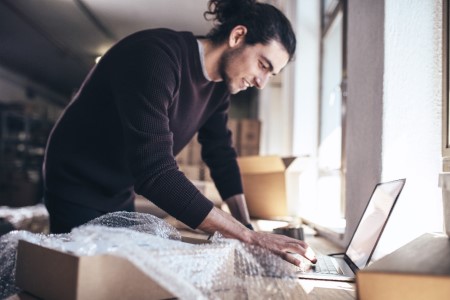Packaging Tips for Safe and Secure Courier Shipments
In the world of courier shipments, the safety and security of your items during transit cannot be overstated. Proper packaging is not just a precaution; it's a necessity. Every day, countless packages are shipped worldwide, and while courier services do their utmost to handle each parcel with care, the journey can be rough. From the sorting conveyors to the back of delivery trucks, your items go through various hands and environments. Common challenges such as impacts, vibrations, temperature fluctuations, and even accidental drops can pose significant risks to the integrity of your goods. This blog aims to arm you with practical advice on packaging techniques, materials, and best practices to ensure that your items arrive at their destination in the same condition they were sent.

Understanding Packaging Materials
4 Types of Packaging Materials
The first step in preparing your item for shipment is choosing the right packaging materials. The most commonly used materials include:
- Bubble Wrap: Ideal for wrapping individual items to provide cushioning and shock absorption.
- Foam Peanuts: Lightweight and perfect for filling voids in boxes, ensuring items remain stationary.
- Corrugated Cardboard Boxes: The go-to choice for external packaging, offering robust protection against impacts.
- Padded Envelopes: Suitable for smaller, less fragile items needing minimal cushioning and protection.
Choosing the Right Material
Selecting the appropriate packaging materials hinges on understanding the specific needs of the item being shipped. Consider the following guidelines:
- Item Type: Electronics require anti-static bubble wrap, while ceramics might need thicker bubble wrap and foam peanuts for extra cushioning.
- Fragility: Fragile items demand multiple layers of protection, including bubble wrap and a sturdy outer box.
- Weight: Heavier items need stronger, double-walled corrugated boxes to withstand the weight without collapsing.
Eco-friendly Options
In response to growing environmental concerns, consider using sustainable packaging materials. Biodegradable packing peanuts, recycled paper or cardboard, and corrugated bubble wrap offer effective yet environmentally friendly alternatives.
Effective Packaging Techniques
Wrapping for Protection
Ensuring your item is well-wrapped is crucial, particularly for fragile items. Follow these steps:
- Cover the item completely with bubble wrap, securing the ends with tape.
- Add additional layers for extra fragile items, ensuring corners and edges are well protected.
- Use stretch wrap for items that might shift to keep them snugly in place.
Filling and Cushioning
The goal is to prevent any movement within the box during transit:
- Fill all voids in the box with foam peanuts or crumpled paper to stop the items from shifting.
- Layer the bottom of the box with cushioning material before placing your item inside, then fill the sides and top before sealing.
Sealing the Package
A well-sealed package is your last line of defence:
- Use strong tape designed for shipping, such as pressure-sensitive packing tape or water-activated tape.
- Apply tape evenly across all flaps and seams in an 'H' pattern to reinforce the box's integrity.
- Avoid using string or paper over-wrap as they can get caught in sorting machinery.
Proper packaging not only ensures the safe arrival of your items but also reflects your commitment to quality and customer satisfaction. By selecting the right materials and employing effective packaging techniques, you can significantly reduce the risks associated with transit and ensure a positive experience for both sender and receiver.
Choosing the Right Box or Container
Size Matters
Selecting the correct size box is crucial for the safety of your items and can also help you save on shipping costs. Here's how to make the right choice:
- Measure Your Item: Before selecting a box, measure your item's dimensions. Add a few inches to each dimension to account for cushioning materials.
- Choose a Snug Fit: The box should be large enough to accommodate the item and cushioning materials without too much excess space. Excessive movement can lead to damage, and too large a box can increase shipping costs.
- Consider the Weight: Ensure the box is rated for the weight of the item you're shipping. Boxes have a maximum weight rating, so choose accordingly to avoid breakages.
Box Condition
The condition of your box is as important as its size. A sturdy box is the foundation of safe shipping:
- Opt for New or Gently Used: New boxes offer the best protection. If reusing a box, ensure it's free from damage, moisture, and any previous shipping labels or markings.
- Check for Strength and Integrity: Look for signs of wear, tear, or creasing. These can compromise the box's strength. Ensure the box flaps are intact and the corners are not dented.
- Double-Boxing for Fragile Items: Consider using two boxes (one inside the other) with cushioning material in between for extremely fragile items. This provides additional protection.
Labelling for Success
Correct Label Placement
Proper label placement ensures your package is efficiently handled and correctly delivered:
- Place on the Largest Surface: The label should be affixed to the largest surface of the box for easy visibility.
- Avoid Seams and Edges: Do not place the label over seams or edges where it could be damaged or torn during handling.
- Use Clear Pouches: If available, place the label inside a clear adhesive pouch to protect it from damage. Alternatively, cover the label with clear tape.
Information to Include
A well-labelled package is the key to ensuring timely and accurate delivery. Your label should include:
- Sender's and Recipient's Full Address: Clearly print or type both addresses. Include contact numbers and, if shipping internationally, the recipient's email address.
- Tracking Number: If provided, make sure the tracking number is visible and not covered by tape.
- Fragile or Special Handling Labels: If shipping fragile items, clearly mark the box as "Fragile" and indicate if the box needs to be kept in a particular orientation (e.g., "This Side Up").
Waterproofing Your Labels
Protecting your labels from weather conditions is essential, especially for long-distance shipments:
- Use Waterproof Labels: Opt for labels made with waterproof materials if possible.
- Clear Packing Tape: Covering your label with clear packing tape can protect it from moisture and handling.
- Avoid Smudging: Use a laser printer for printing labels, as inkjet prints can smudge when wet.
By carefully selecting the right box and ensuring your labels are clear, secure, and protected from the elements, you can greatly improve the likelihood of your items arriving safely and on time. Proper packaging and labelling are not just about following protocols; they're about delivering your commitment to quality and care to the recipient.
Special Considerations for Specific Items
Electronics
Shipping electronics requires extra care due to their sensitivity and value. Follow these guidelines to ensure they arrive safely:
- Use Anti-Static Materials: Wrap electronics in anti-static bubble wrap or foam to prevent damage from electrostatic discharge.
- Securely Pack Batteries: If shipping electronics with batteries, ensure they are securely installed or packed in separate, clearly marked bags to prevent short circuits.
- Double Box: Place the wrapped item in a box with cushioning, then place that box in a larger box filled with additional cushioning material for extra protection.
Artworks and Fragile Items
Artworks and highly fragile items demand custom solutions:
- Custom Crating: Consider having a custom crate built for large or uniquely shaped artworks. This provides tailored protection against impacts and vibrations.
- Padding and Layering: Use foam padding, bubble wrap, and rigid cardboard to create multiple layers of protection. Pay special attention to corners and edges.
- Vertical Packing: Whenever possible, pack paintings and framed items vertically to reduce the risk of damage if pressure is applied to the top of the package.
Liquids
Shipping liquids requires careful packaging to prevent leaks and spills:
- Tight Sealing: Ensure all liquid containers are tightly sealed with tape around the lid or cap. Place them in leak-proof bags as an additional safeguard.
- Upright Position: Clearly mark the package to indicate the upright position to keep liquids from leaking.
- Absorbent Material: Include absorbent material like paper towels or absorbent pads within the packaging to soak up any potential leaks.
Final Checklist Before Shipping
Inspection
Before sealing your package for the final time, perform these checks:
- Shake Test: Gently shake the box to ensure there is no movement inside. If you hear or feel shifting, add more cushioning.
- Seal Strength: Double-check the tape on all seams and openings. It should be secure with no loose ends.
- Label Clarity: Ensure the label is clear, correctly placed, and securely affixed.
Insurance and Documentation
For high-value items, consider these precautions:
- Insurance: Opt for shipping insurance to protect against loss or damage. Ensure the coverage amount matches the item's value.
- Documentation: Keep a copy of all shipping documents, including tracking numbers, receipts, and insurance paperwork. For international shipments, ensure you have the correct customs documentation.
Conclusion
Effective packaging plays a pivotal role in the safety and security of courier shipments. The journey your package undertakes is filled with potential hazards, but with the right materials, techniques, and considerations, you can significantly mitigate these risks. Whether you're sending electronics, artworks, liquids, or any other items, taking the time to package them properly is an investment in peace of mind. By following the advice outlined in this guide, you're not just sending a package; you're ensuring it arrives in the same condition it left, maintaining trust and satisfaction with your recipients. Let's prioritise safe and secure packaging to make every delivery a success.
